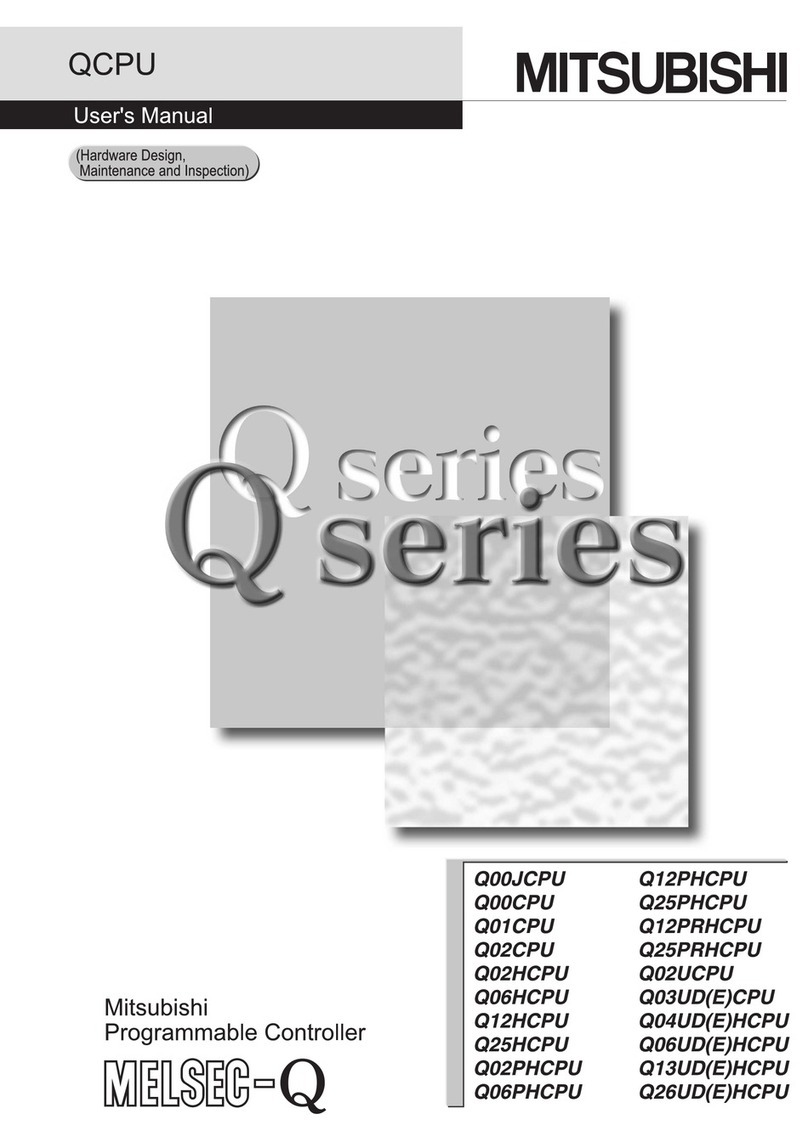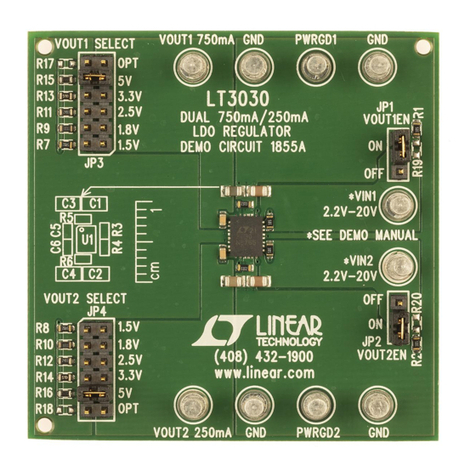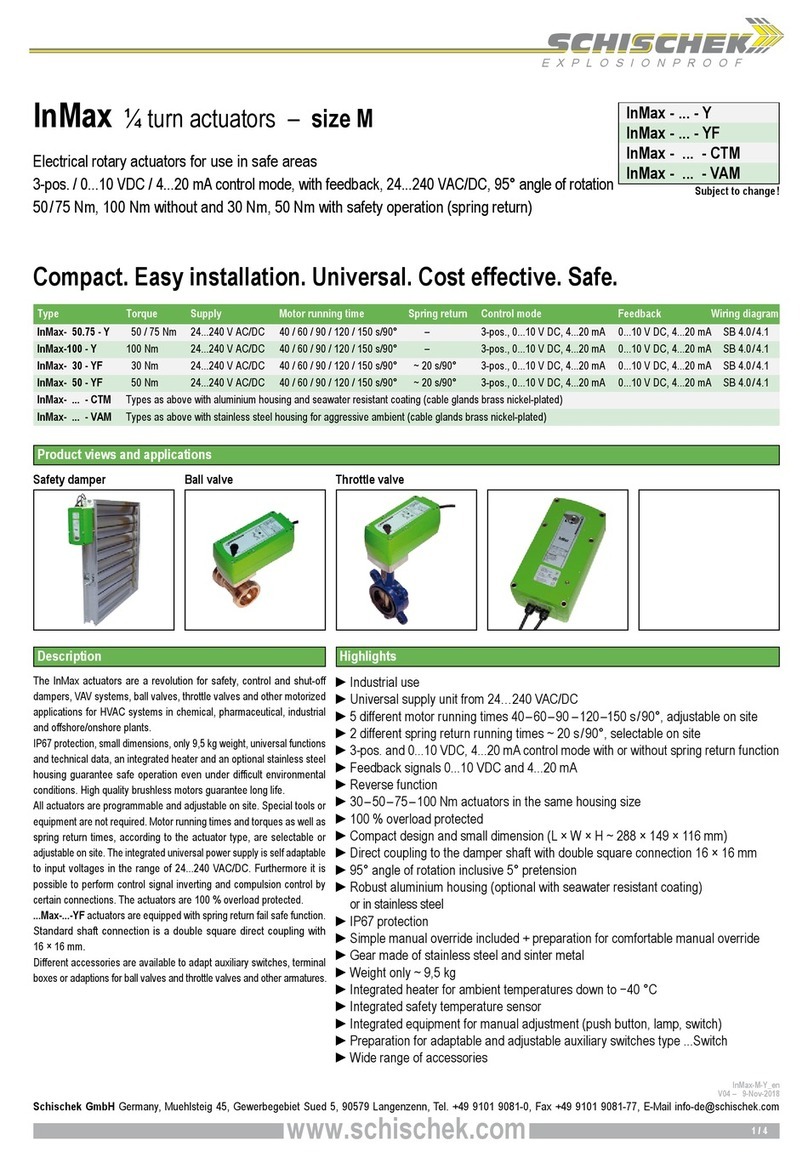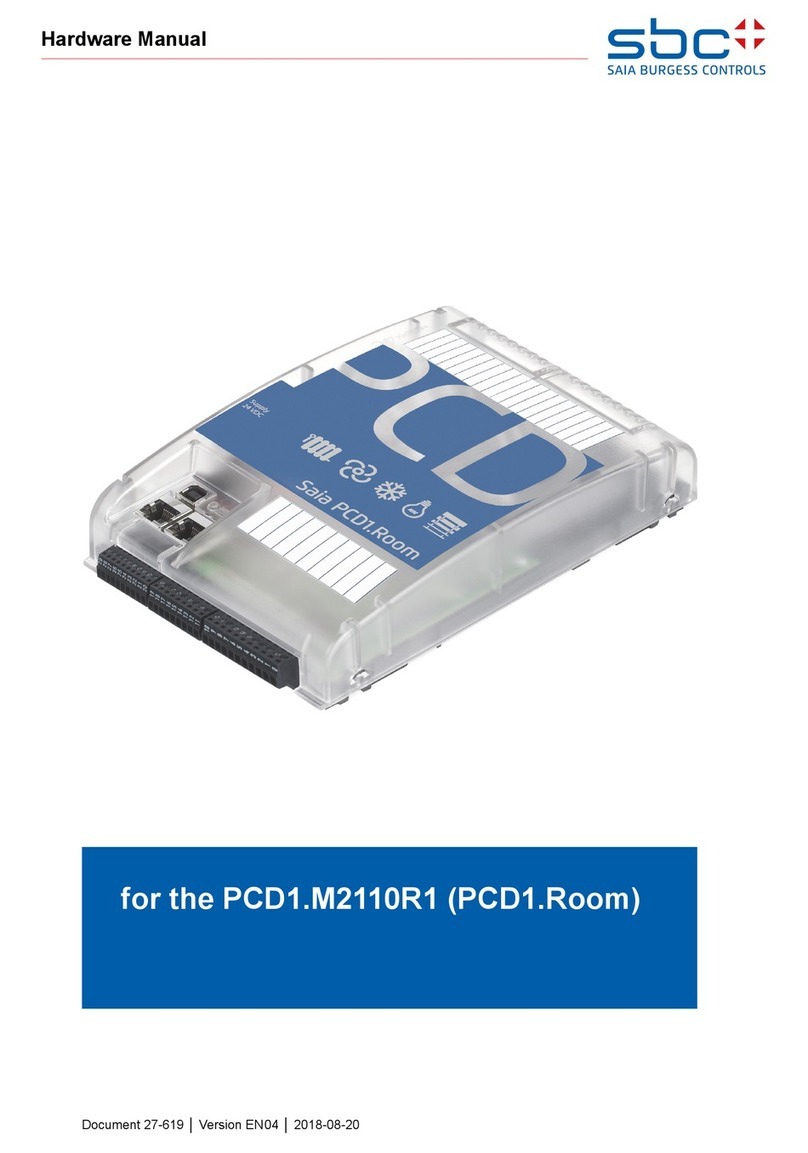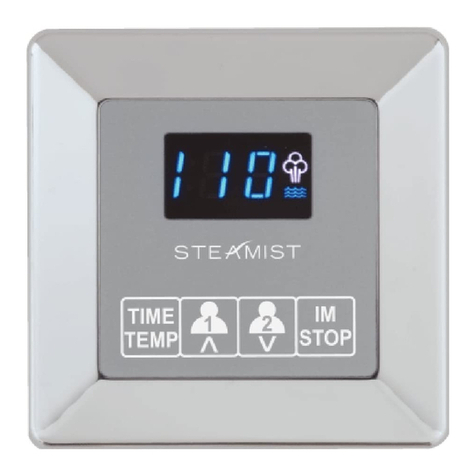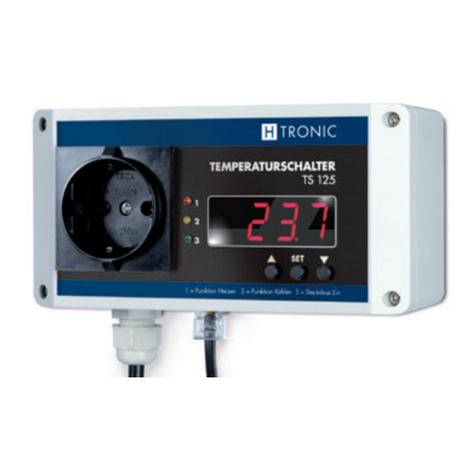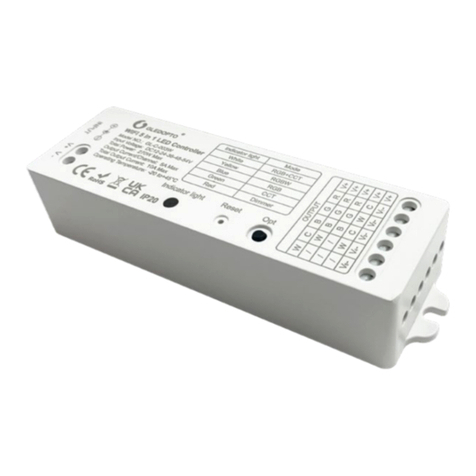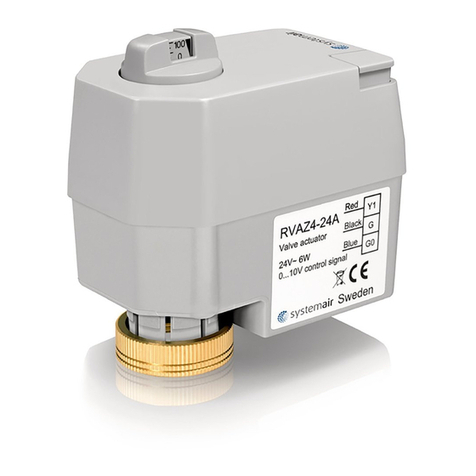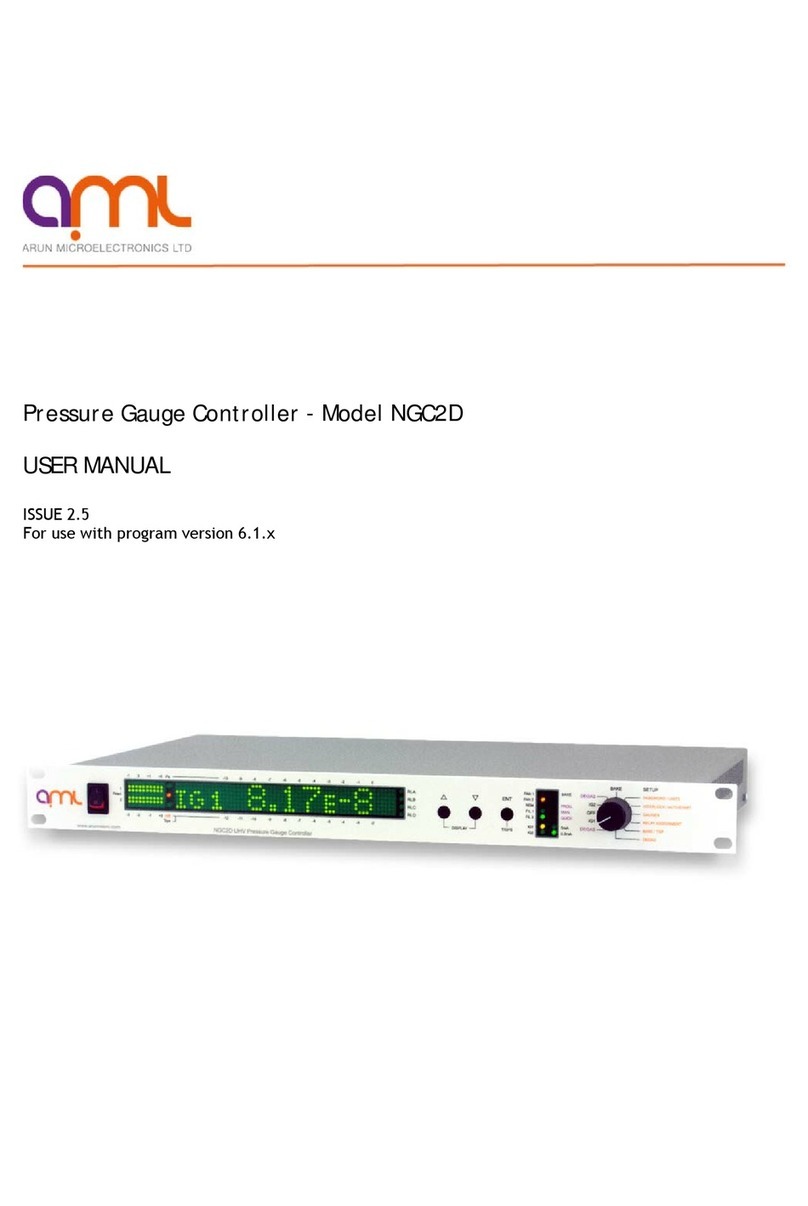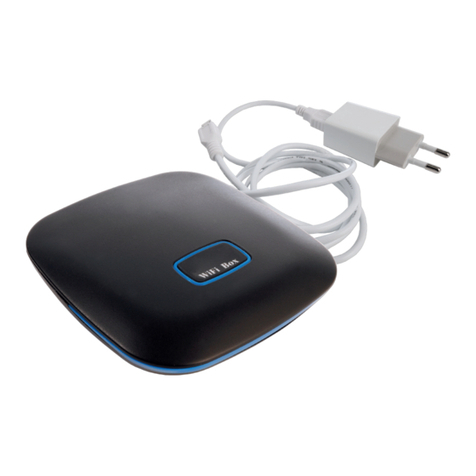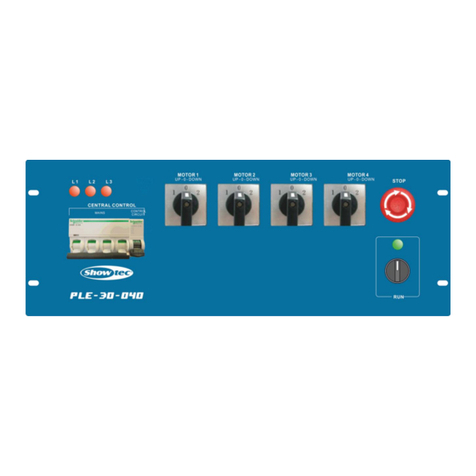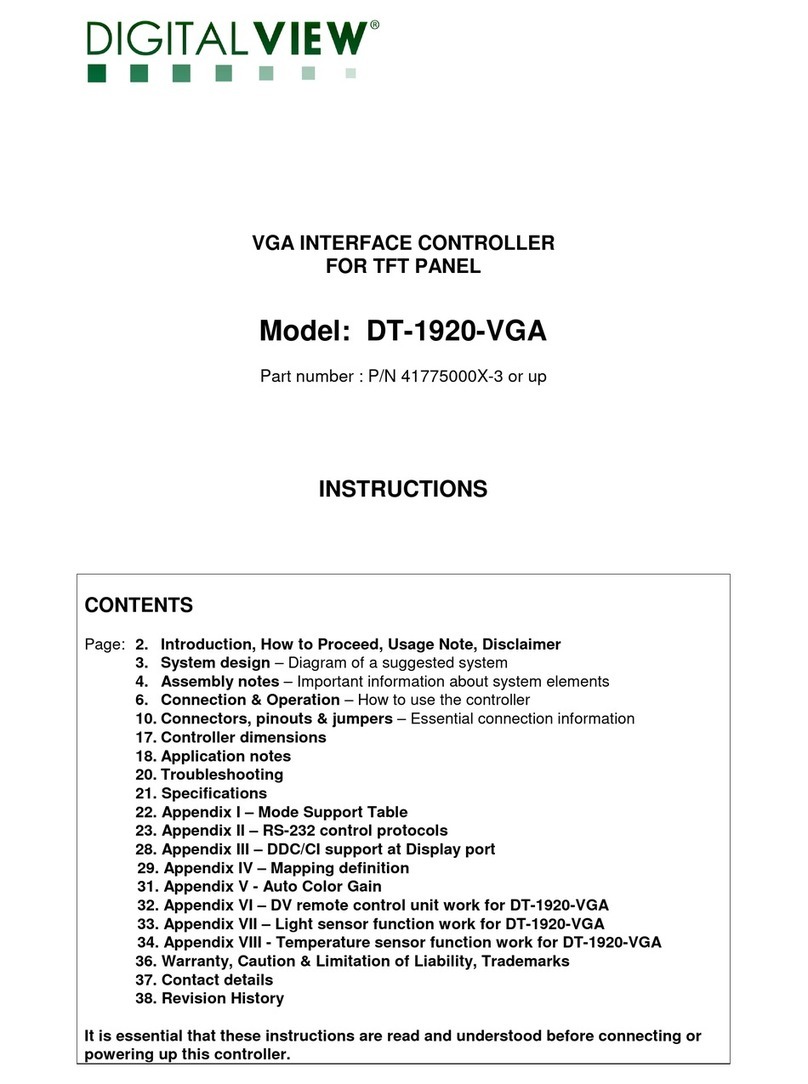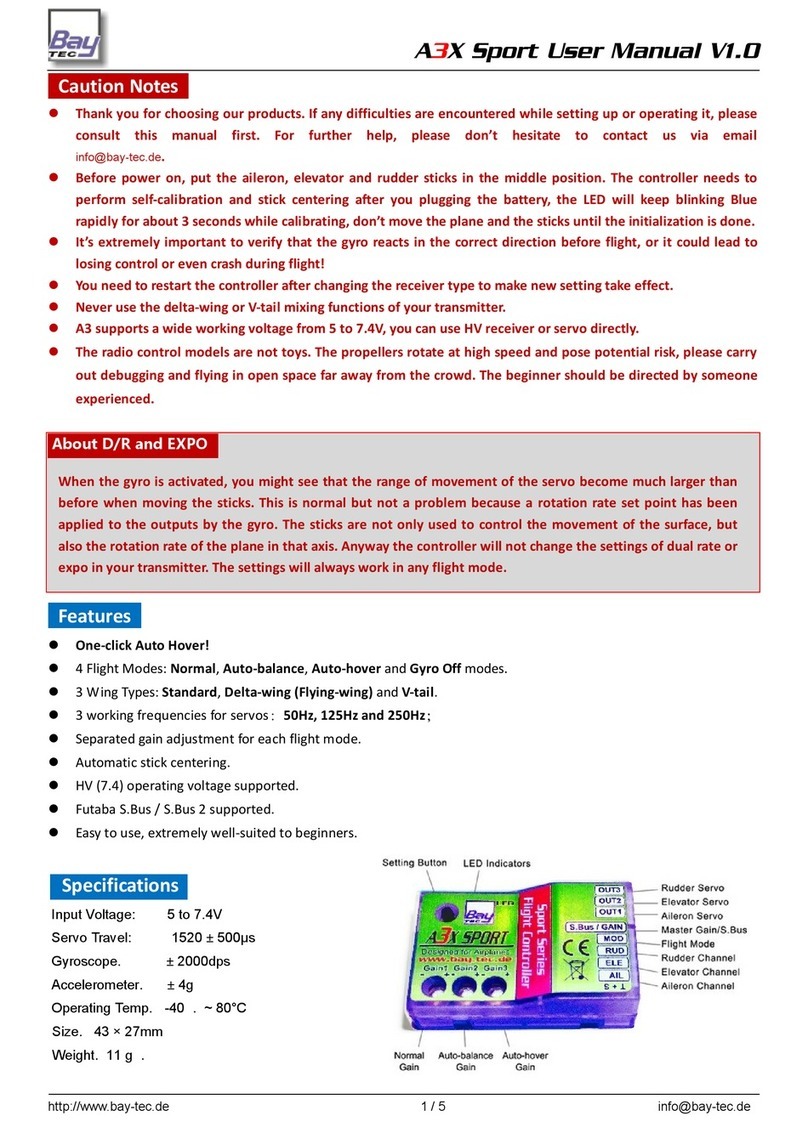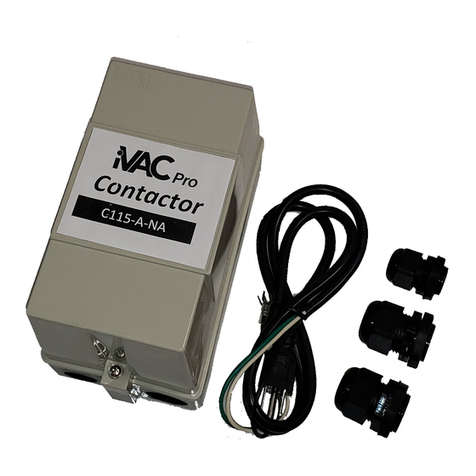SD System VFW-III User manual

)
VFW-III
J
ERSAFLOPPY
WINCHESTER
DISK
CONTROLLER
OPERATIONS
MANUAL
SD
#7140174
REVISION A
SEPTEMBER 21, 1983
.•
P.O. B
ox
28810, Dal
las
, Te
xas
75228

)
)
)
VFW-III
VERSAFLOPPY
WINCHESTER
DISK
CONTROLLER
SD
#7140174
REVISION
A
SEPTEMBER
21,
1983
OPERATIONS
MANUAL
•


TABLE
OF
CONTENTS
Subsection
Page
Number
Title
No.
SECTION
I
INTRODUCTION
1.0
GENERAL
1-1
1.1
FEATURES
1-1
1.2
SCOPE
1-2
SECTION
II
THEORY
OF
OPERATION
2.0
GENERAL
2-1
2.1
S-100
COMPUTER
BUS
2-1
2.2
WINCHESTER
DISK
DRIVES
2-3
2.3
FLOPPY
DISK
DRIVES
2-5
2.4
VFW-III
DISK
CONTROLLER
2-6
2.4.1
Zone
1:
Winchester
Control
2-6
2.4.2
Zone
2:
Buffer
Control
and
Support
Logic
2-7
2.4
. 3 Zone
3:
Status
and
Control
Port
2-7
2.4.4
Zone
4:
Basic
S-100
Interface
2-7
2.4.5
Zone
5:
TMA
Interface
2-7
2.4.6
Zone
6:
Control
Processor
2-7
)
2.4.7
Zone
7:
Floppy
Disk
Interface
2-8

3.0
3.1
3.1.1
3.1.2
3.
1.2
.1
3.
1
.2.2
3.1.2.3
3.
1.
2.3.1
3.1.2.3.2
3.1.2.3.3
3.1
.2.4
3.1.2.5
3.1.2.6
3
.1.3
3
.1.4
3.1.5
3 .
1.6
3.1.7
3.
1
.8
3.
1
.9
3.1.9.1
3.1.9.2
3.1.9.3
3.1.9.4
3.1.9.5
3.1.9.6
3.1.9.7
3.1.10
3.1
.11
3.1
.1
2
3.1.13
3
.1.14
3.1.14.1
3.1.14.2
3.1.14.3
3.1.14.4
3.1.14.5
3.1.14.6
3
.1.1
4.7
3.2
3.2.1
3.2
.
1.l
3
.2.1.2
3
.2.1.
3
3 . 2
.2
3.2.2.1
3.2.2.2
3.2.3
3.2.3.1
3
.2.
3 . 2
3.2
.
3.3
GENERAL
MEMORY
MAP
SECTION
III
SOF'IWARE
DRIVERS
SECTOR
BUFFER
(READ/WRITE
AND
INCREMENT)
ERROR
REGISTER
(READ
ONLY)
NO
DATA
ADDRESS
MARK
TRACK
0
NOT
FOUND
COMMAND
ABORTED
STATUS
REGISTER
BIT
6:
READY
STATUS
REGISTER
BIT
5:
WRITE
FAULT
STATUS
REGISTER
BIT
4:
SEEK
COMPLET
E
IDENTIFICATION FIELD
NOT
FOUND
UNCORRECTABLE
ERROR
BAD
BLOCK
DETECT
WRITE
PRECOMPENSATION
CYLINDER
(WRITE
ONLY)
SECTOR
COUNT
(READ/WRITE)
SECTOR
NUMBER
(READ/WRITE)
CYLINDER
LOW
(READ/WRITE)
CYLINDER
HIGH
(READ/WRITE)
SIZE/DEVICE/HEAD REGISTER (READ/WRITE)
STATUS
REGISTER
(READ
ONLY)
ERROR
ENCOUNTERED
(BIT
0)
ECC
CORRECTION
MADE
(BIT
2)
DATA
TRANSFER
REQUESTED
(BIT
3)
SEEK
COMPLETE
(BIT
4)
WRITE
FAULT
(BIT
5)
DRIVE
READY
(BIT
6)
VFW
-
III
BUSY
(BIT
7)
COMMAND
REGISTER
(WRITE
ONLY)
TMA
LEAST
SIGNIFICANT
BYTE
(WRITE
ONLY)
TMA
MOST
SIGNIFICANT
BYTE
(WRITE
ONLY)
TMA
EXTENDED
SIGNIFICANT
BYTE
(WRITE
ONLY)
VFW-III
CONTROL
PORT
(WRITE
ONLY)
8"
FULL
SIZE
FLOPPY
SELECT
(BIT
0)
EXTENDED
HEAD
SELECTION
(BIT
1)
SINGLE DENSITY SELECT {BIT 2)
MOTOR-ON
MODE
(B
IT 3)
TEMPORARY
MASTER
ACCESS
DIRECTION
(BIT
4)
TEMPORARY
MASTER
ACCESS
ENABLE
{BIT 5)
EXTENDED
PROM
DISABLE
(BIT
7)
VFW-III
COMMAND
SET
Type
1 Commands
Restore
Command
Seek
Command
Diagnostic
Test
Command
Type
2 Commands
Read
Command
Readlong
Command
Type
3 Commands
Write
Command
Writelong
Command
Format
Command
3-1
3-1
3-2
3- 2
3-3
3-3
3-3
3-3
3-4
3-4
3-4
3
-4
3-4
3
-4
3-5
3-5
3-5
3-5
3-6
3-6
3
-7
3-7
3-7
3-7
3-7
3-7
3-7
3-8
3-8
3-8
3- 8
3-8
3-8
3-9
3-9
3-9
3-9
3
-9
3-10
3-10
3-
1 0
3-11
3-12
3-12
3-12
3-12
3-13
3-13
3-13
3-13
3-13
)
)
)

)
Subsection
Number
4.0
4.1
4.2
4.2.1
4.2.2
4.2.3
4.3
4.3.l
4.3.2
4.4
4.4.1
4.4.2
4.4.2.1
4.4.2.2
4.4.2.3
4.4.3
4.5
4.5.1
4.5.2
5.0
5.1
5.2
APPENDICES
A
B
c
D
E
F
G
H
I
J
TABLE
OF
CONTENTS--Continued
GENERAL
Title
SECTION
IV
INSTALLATION
POWER
AND
COOLING
CABLES
FLOPPY
DISK
DRIVES
TEST
CONNECTOR
WINCHESTER
DISK
DRIVES
JUMPERS
AND
SWITCHES
JUMPERS
SWITCHES
CALIBRATION
TEST
MODE
FOR
THE
VFW-III
FLOPPY
DISK
CONTROLLER
CALIBRATION
FLOPPY
DISK
WRITE
PRECOMPENSATION
FLOPPY
DISK
READ
PULSE
WIDTH
FLOPPY
VOLTAGE
CONTROLLED
OSCILLATOR
CENTER
FREQUENCY
WINCHESTER
VOLTAGE
CONTROLLED
OSCILLATOR
NON-IEEE-696
BUSSES
PIN
ASSIGNMENTS
DATA
TRANSFER
MODES
GENERAL
SECTION V
SPECIFICATIONS
POWER
REQUIREMENTS
ENVIRONMENT
SELECTED
IEEE-696
SPECIFICATION
SH
EE
TS
DISCLAIMER
LIMITED
WARRANTY
FLOPPY
INTERFACE
WINCHESTER
INTERFACE
PAL
SPECIFICATION
FLOPPY
DISK
DRIVER
SOFTWARE
PARTS
LIST
FOR
VFW-III
PARTS
PLACEMENT
DIAGRAM
SCHEMATIC
Page
No.
4-1
4-1
4-1
4-1
4-2
4-2
4-3
4-3
4-6
4-7
4-7
4-7
4-8
4-8
4-8
4-8
4-9
4-9
4-10
5-1
5-1
5-1
A-1
B-1
C-1
D-1
E-1
F-1
G-1
H-1
I-1
J-1

Figure
No.
2-1
ILLUSTRATION
Title
VFW-III
BLOCK
DIAGRAM
Page
No
.
2-2
)
)
)

)
)
1.0
GENERAL
SECTION
I
INTRODUCTION
The
SDSystems
VFW-III
is
a
high
performance
disk
controller
capable
of
running
both
Winchester
hard
disk
and
floppy
disk
drives.
This
unique
design
brings
together
the
function
of
several
controller
boards
onto
a
single
S-100/IEEE-696
compliant
board.
Winchester
drives
designed
for
the
industry
standard
ST506/412
interface
comprising
up
to
16
read/write
heads
and
floppy
disk
drives
of
single
or
double
density,
single
or
double
sided
and
5.25"
minis
or
8"
full
size
configurations
may
be
controlled
concurrently
by
the
VFW-III.
Data
may
be
interchanged
with
the
controller
via
a
DMA
mode
wherein
the
board
becomes
a
Temporary
Master
capable
of
addressing
any
location
within
the
24
bits
of
address
defined
by
the
IEEE-696
specification,
or
via
a
programmed
I/O
mode
wherein
data
is
sequentially
transferred
through
a
single
port
of
the
controller.
On-board
processors
transfer
sector
data
between
the
internal
sector
buffer
and
the
selected
drive
without
need
of
the
host
processor's
supervision,
thus
freeing
the
host
for
other
activities
such
as
servicing
interrupts.
Automatic
retries.
CRC
generation/verification
and
optional
er
r
or
co
r r e
ct
ion
(on
ha
r d d i s k
tr
ans
f e r s )
of
a
sing
1e ·
bur
s t
error
of
five
bits
ensure
data
integrity
and
further
unburden
the
CPU
from
monitoring
these
events.
1.1
-
FEATURES
Versatile
Disk
Configurations:
Three
varied
5.25"
Winchest
.
er
hard
disk
drives
utilizing
the
ST506/412
interface
with
up
to
16
read/write
heads
may
be
controlled
by
the
VFW-III,
along
with
four
floppy
disk
drives
in
any
mixed
configuration
from
single
sided,
single
density,
5.25"
minis
to
double
sided,
double
density,
8"
full
size
drives.
-
Fully
S-100/IEEE-696
Compliant:
-
When
operating
as
a
Temporary
Master,
the
controller
can
perform
eight
bit
Direct
Memory
Accesses
(DMA)
for
faster
transfers
of
data
between
the
sector
buffer
and
any
memory
location
within
the
extended
memory
addressing
range
of
16Mbytes
(24
bit
addressing).
Data
Integrity:
Single
burst
errors
of
up
to
five
bits
are
automatically
corrected
on
data
received
from
5.25"
Winchester
drives
formatted
in
ECC mode.
Single
burst
errors
of
20
bits
and
double
burst
errors
of
four
bits
can
be
detected
from
a 256
byte
sector.
1-1

-
-
Convenient
Packaging:
By
supplying
the
function
of
two
controllers
in
a
single
board,
the
VFW-III
allows
existing
systems
to
expand
to
Winchester
drives
without
sacrificing
an
S-100
slot
and
allows
new
systems
to
get
more
system
performance
into
small
card
cages.
Two
regulators
and
heatsinks
have
been
used
to
assure
adequate
cooling
even
under
conditions
where
the
8
volts
unregulated
input
is
at
its
IEEE-696
maximum
value
of
11
volts
DC.
Care
has
been
taken
to
place
all
cable
connectors
along
the
top
edge
of
the
board
for
optimum
access.
Flexible
Data
Storage
and
Transfers:
Sector
sizes
of
128,
256,
512
and
1024
bytes
and
physical
placement
of
the
logical
sectors
for
interleaving
are
both
software
selectable.
The
VFW-III
processors
supervise
a1·1
disk
to
on-board
single
sector
buffer
transfers,
requiring
only
that
the
host
CPU
issue
the
command
sequence
and
later
evaluate
the
command
completion
status.
When
Temporary
Master
OMA
transfers
are
used,
a
completion
interrupt
may
be
issued
after
all
sectors
have
transferred
between
the
host
memory
and
the
selected
drive.
Using
programmed
I/O
mode
requires
the
host
CPU
to
move
sector
data
between
the
on-board
buffer
and
host
memory.
-
Interruptable
Data
Transfers:
When
operating
the
VFW-III
under
programmed
I/O
transfer
mode,
interrupts
may
be
serviced
in
the
middle
of
a
sector
buffer
to
host
transfers.
On
board
processors
transfer
sector
data
between
the
internal
:·
sector
buffer
and
the
selected
drive
without
need
of
the
host
processor's
supervision.
In
this
mode
of
operation,
no
interrupts
need
be
missed.
1.2
SCOPE
OF
THIS
MANUAL
I
This
manual
is
divided
into
five
sections,
each
directed
toward
a
need
of
the
user.
Section
I
summarizes
the
board's
features
and
defines
the
structure
of
the
manual.
Section
II
defines
terms
involved
in
disk
operation,
basic
flow
of
information
on
the
VFW-III
and
location
of
various
circuits
on
.
the
schematics.
It
is
written
with
the
novice
in
mind
and
is
an
easy
introduction
into
rotating
media
storage
devices.
Information
required
to
write
or
modify
a
software
driver
is
presented
in
Section
III.
It
includes
the
memory
map
of
the
controller
and
the
command
set
to
it.
Sectio~
IV
contains
all
information
required
to
physically
install
the
board
into
an
existing
system
and
the
power
and
cooling
requirements
of
the
board
• .
specifications
of
the
VFW-III
are
listed
in
the
last
section.
Reference
material
is
located
in
the
appendices.
]
.
. I
I .
1-2
)
)

--
2.
0 GENERAL .
SECTION
II
THEORY
OF
OPERATION
Section
II
is
intended
to
be
used
as
a
light
tutorial
on
the
S-100
computer
bus,
the
Winchester
and
floppy
disk
drives,
and
the
interface
that
connects
them
together.
The
block
diagram
(Figure
2-1)
illustrating
the
functions
of
the
VFW-III
is
discussed
in
Section
II,
Subsection
2.4.
2.1
S-100
COMPUTER
BUS
The
S-100
computer
bus
has
a
100
pin
parallel
backplane.
This
means
that
the
slot
in
which
a
board
is
plugged
into
the
bus
is
inrnaterial.
Information
required
for
any
card
on
the
bus
is
pr
·
esented
to
every
location.
An
addressing
scheme
is
used
to
specify
which
board
is
to
respond
to
the
following
bus
cycle.
The
S-100
defines
two
basic
transfers;
the
memory
access
and
the
input/output
(I/O)
device
access.
The
address
of
a
memory
location
can
be
either
16
or
24
bits
long
for
either
65,536
or
16,777,216
memory
locations.
The
address
of
an
I/O
port
can
be
either
8
or
16
bits
long
for
a
range
of
256
or
65,536
locations.
S-100
boards
monitor
the
bus·
for
an
address
within
the
range
of
locations
which
it
alone
contains.
Once
selected
by
the
address,
a
board
w.
ill
perform
the
command
presented
on
the
control
lines.
All
addressing
is
done
by
one
board
at
a
time;
either
the
permanent
master
or
one
of
16
temporary
masters.
The
permanent
master
is
usually
the
main
CPU
and
will
relinquish
the
bus
using
a
priority
scheme
that
ensures
that
only
one
master
is
controlling
the
bus
at
a
given
time.
The
VFW-III
can
speed
data
across
the
bus,
avoiding
the
two
step
process
w
herein
the
CPU
first
·
reads
fr
om
the
controller
and
second
writes
into
memory,
by
becoming
a
temporary
master.
This
allows
the
VFW-III
to
transfer
data
directly
between
its
single
sector
buffer
and
any
memory
location
within
in
a
range
of
16,777,216
locations.
Data
transferred
in
this
fashion
is
quicker
but
may
not
be
chosen
for
an
application
where
real-
time
interrupts
must
be
handled
quickly.
TMA
transfers
disable
the
CPU
from
accessing
the
bus
to
service
a
pending
interrupt
until
after
the
current
sector
is
transferred.
Operating
the
controller
in
a
programmed
I/O
mode,
where
the
CPU
always
controls
the
bus
and
moves
data
in
the
slower
two-
step
process
described
above,
allows
immediate
access
to
the
bus
for
servicing
interrupts
in
the
middle
of
data
transfers
without
disturbing
them.
In
this
mode,
all
transfers
made
with
the
controller
are
I/O
transfers.
2-1

ZONE 1-WINCHESTER CONTROL
ZOHE
2-8UFFER
CONTROL
ANO
SUPPORT LOGIC
ZONE
3-
STATUS ANO CONTROL POAT
ZONE,-BASIC
$100
INTERFACE
ZONE
S-TMA
INTERFACE
ZOHE6-CONTAOL
PROCESSOA
ZONE
7-FLOPPY
DISK INTERFACE
S'IOO
ZONE 1
INnANAL
DATA
BUS
WINCHESTER
INTERFACE ANO
DATA
SEPARATOR
I
I
WD1010 WINCHESTER
DISK CONTROLLER
-
--
-
-
--
VFW-III
llOCk
DIAGRAM
-
J4
-
Je
J7
.
J8
INTERNAL
CONTROL BUS
51110
.......
--- - -----_
....
-
--
---
---
~
._.
.-..
.....
--
.--.
--
._
-
_.
--
--
W010~
ERROR
ZONE2
--OETECTtON ·suPPORT --
LOGIC
• t
SECTOR
ADDRESS
---
-
BUFFER COt.NTER
......
~
- -
._.
--
- - --
_._
-,._.,_
_.
-.
- - .._.,
._
-
.....
-.
-- -
--
..._,
---
...-
ZONE 3 CONTROL PORT STATUS PORT
--------~-
-
--
-
...
~
--------
-~
-
._.
.-
-- -
-.
~
-
--
DATA
aus
CONT9'0l
•us
. ---
INTERFACE
ZONE4..._
______________
~
INTERFACE
....
--
~
-- - --
--
-
-~
-- -
---
~
_.
- - -
...
~
- -
.....
~
.-
-.
._.
-
......
-
TEMPORARY
MA.STEA
-
OMA
--
~ONE
5
A.ODRESS
INTERFACE
TEMPORAR'f'
MASTER
OMA
COHTAOl
INTERFACE --
~
--
- - -
-- --
-
--
-
...
._
-
.....
._.
--- - -
--~
---
--
- - -
.,...._.
--
W01015
ZONE 8 -. CONTROL
PA()CS:f;"""~-:;c-,..
.....
_~
ADDRESS ANO
-CONTROL
LATCH
•
-
CONTROl
PROCESSOR
EXTERNAL PROM
ii---
.-.
- -
---
~
- - - -
---
- -
._._.
~
.....
...._..
- - -
-~
- - -
__.
~
.....
- -
....
-
ZONE 7
5100
INTERHAL
~TA
BUS
Figure
2-1.
--
W02797
FLOPPY
OtSI'.
CONTROLLER
I I
1
A..OPf>Y 01$1(
INTERFACE
.•
INTERNAL
COHTROl
BUS
:.
J2
...
-------~J
3
VFW-III
BLOCK
DIAGRAM
2-2
$100
)
)

An
interrupt
bus
is
defined
under
the
S-100
to
stop
the
CP
U
to
quickly
do
a
time-dependent
routine
transparent
to
the
present
task.
In~errupts
are
commonly
used
to
get
the
CPU
to
transfer
data
with
an
input/output
device
and
are
more
efficient
than
polling
status
loops
where
many
wasted
reads
are
made
until
the
status
changes,
signalling
an
operation
needed
to
take
place.
Status
loops
seldom
respond
as
quick
as
interrupts.
Data
lines
exist
for
moving
either
8
bit
bytes
or
16
bit
words
during
memory
or
I/O
transfers.
All
data
transfers
to
or
from
the
VFW-III
will
be
8
bit
byte
length
only
•
.
2.2
WINCHESTER
DISK
DRIVES
Winchester
disk
drives
are
rotating
memory,
random
access
storage
devices
which
fulfill
the
need
for
fast,
large,
on-
line
data
storage
and
retrieval.
The
word
Winchester
a c·t u a
11
y r e f e r s t o
th
e t e c hn o1 o gy .
of
.
the
ni c ke
1-
z i nc
formulated
read
·
/write
head,
but
is
commonly
used
to
refer
to
5.25"
hard
disk
drives.
The
term
"Winchester
disk
drive"
is
used
interchangeably
with
•hard
disk
drive"
throughout
this
manual.
A
hard
disk
drive
is
a
device
which
allows
access
to
data
stored
magnetically
within
a
vertical
stack
of
several
magnetic
coated
disks
or
platters.
The
stack
is
continuously
spinning
at
speeds
roughly
12
times
as
fast
as
a
floppy
disk
drive
with
the
read/write
heads
aerodynamically
"flying"
microns
above
each
sur
·f
ace
in
the
stack
(two
heads
pe
r
platter;
top
and
bottom).
All
heads
are
attached
to
an
assembly
som~times
called
an
actuator
ara,
which
can
be
controlled
to
position
the
heads
in
or
out
along
·
the
radii
of
the
stack.
At
any
given
position
of
the
read/write
heads,
the
magn~tic
media
spinning
below
it
that
could
be
read
or
written
would
trace
out
a
circle
on
the
media.
This
circle
is
called
a
track.
At
each
position
of
the
actuator
arm,
its
associated
track
is
assigned
a
trac
·k
number.
Track
numbe
·
rs
range
from
zero
at
the
outermost
concentric
circle
to
the
maximum number
located
nearest
the
stack
axis.
The movement
of
.
the
actuator
arm
from
one
track
to
another
is
termed
a
seek
and
is
issued
by
the
controller
as
a
series
of
pulses
called
steps.
The
time
required
to
electically
switch
from
one
read/write
head
to
·
another
·
above
o·r
below
it
is
considerably
less
than
the
time
taken
to
seek
from
one
track
to
its
neighboring
~rack.
For
this
reason,
when
the
end
of
one
track
has
been
reached,
the
continuation
of
information
will
be
found
on
the
same
track
number
but
on
the
next
higher
head
number.
The
vertical
stack
of
tracks
accessed
by
all
the
heads
of
the
actuator
arm
is
referred
to
as
a
cylinder.
Information
in
the
present
cylinder
can
be
accessed
the
quickest.
When
consecutive
data
passes
the
end
of
a
cylinder
boundary,
a
seek
must
be
issued
and
the
head
number
is
reset
to
zero.
2-3

The
OEM
manual
or
product
specification
of
every
drive
gives
the
unformatted
capacity
of
the
entire
drive
and
of
an
individual
track.
This
is
the
number
of
locations
where
bits
of
information
may
reside.
Since
each
of
these
bits
cannot
be
uniquely
addressed,
a
method
is
used
that
sacrifices
some
of
the
bits
to
identify
blocks
of
continuous
data.
While
this
scheme
is
common
among
controller
manufacturers,
the
identification
blocks
must
be
identical
to
allow
information
written
by
one
company's
controller
to
be
read
by
another's.
Th
e
VF
w- I I I
use
s a
wester
n Dig
it
a1 40
pin
ch
i p
to
hand
1e
th
e
foraatting
or
writing
of
the
pattern
required
for
subsequent
reads
and
writes.
As
this
chip
gains
popularity
in
the
market
place,
com
pa
tibili
ty
among
control
le
rs
w
il
1
increase.
It
is
important
to
point
out
that
more
is
involved
than
the
physical
access
·
to
the
old
data.
The
driving
software
·
must
also
be
compatible.
Each
track
is
subdivided
into
units
called
sectors.
The
data
field
which
contains
the
information
to
be
read
or
written
is
accompanied
by
an
identification
or
ID
field
and
gaps
before,
between
and
following
these
fields.
The ID
field
contains
the
"address"
of
the
sector
and
includes
the
cylinder
number,
the
head
number
and
the
sector
number.
This
is
the
information
that
the
Central
Processing
Unit
(CPU)
or
host
processor
must
provide
to
the
controller
board
in
order
to
transfer
the
associated
data
field.
The
controller
takes
all
action
nessessary
to
locate
the
target
sector
and
transfer
the
data
field
between
the
drive
and
the
controller's
on-board
single
sect
or
buff
er.
All
tr
an
sf
e
rs
be
tween
the
ho
st
and
.
the
controller
are
independent
of
transfers
between
the
controller
and
the
drives.
This
means
that
the
host
needn't
be
"locked-
up"
as
it
waits
to
move
data
directly
with
the
drive
as
·
some
controllers
require.
If
programmed
I/O
·mode
is
used
to
move
data
with
the
controller,
any
higher
level
interrupts
or
conditions
requiring
immediate
action
may
be
handled
in
..
the
middle
of
the
transfer,
only
to
complete
it
after
the
interrupt
has
been
serviced.
An
index
pulse
is
used
to
the
controller
when
a
reference
radius
of
the
disk
stack
passes
below
the
read/write
heads.
This
reference
is
used
to
initiate
formatting
physical
sectors,
which
are
the
actual
·
sector
fields
placed
consecutively
along
the
track.
To
increase
the
throughput
or
average
rate
at
which
information
is
transferred
on
a
track,
a
technique
known
as
sector
interleaving
is
used.
If
physical
sectors'
ID
fields
contain
consecutive
numbers
(an
interleave
factor
of
1),
a
dilemma
occurs
when
two
sectors
are
to
be
read.
As
the
first
sector
spins
under
the
.
read/write
head,
its
ID
field
matches
the
target
sector,
and
the
following
data
field
is
transferred
into
the
controller's
single
sector
buffer.
When
the
last
bytes
of
data
are
read
in,
the
cont
·
roller
begins
to
move
the
saved
data
into
the
host
system's
memory,
at
the
same
time
that
the
next
target
sector
is
spinning
past
the
read/write
head.
The
disk
controller
2-4
)

)
)
then
returns,
looking
for
the
next
target
sector's
ID
field,
and
now
must
wait
a
full
revolution
for
it
to
spin
under
•
again.
Sector
interleaving
makes
a
distinction
between
the
physical
sector
and
the
logical
sector.
A
logical
sector
is
the
next
sector
that
the
system
would
request,
but
its
position
is
staggered
around
the
disk
so
that
while
the
buffer
is
moved
into
the
host,
unwanted
sectors
spin
below
the
read/write
head.
Shortly
after
the
controller
returns,
searching
for
the
next
logical
sector,
it
spins
under
the
head.
The
minimum
interleave
factor
the
VFW-III
handles
on
a
Winchester
is
3;
every
third
physical
sector
is
the
next
logical
sector.
The
table
below
illustrates
an
imaginary
case
where
16
sectors
of
512
bytes
length
are
formatted
with
an
interleave
factor
of
3.
Physical
Sector
1 2 3 4 5 6 7 8 9
10
11
12
13
14 15
16
Logical
Sector
1
12
7 2
13
8 3
14
9 4
15
10
5 16 11 6
1st
Revolution
1 • • 2 • • 3 • • 4 • • 5 • • 6
2nd
Revolution
• • 7 • • 8 • • 9 • •
10
• •
11
•
3rd
Revolution
•
12
• • 13 • •
14
• •
15
• • 16 • •
This
shows
that
the
entire
track
can
be
read
in
3
revolutions
with
an
interleave
factor
of
3
as
opposed
to
16
revolutions
(1
per
sector)
for
an
interleave
factor
of
1
or
2.
This
increases
the
throughput
by
5.3
times.
The
interleave
factor
is
set
only
when
a
drive
is
formatted
and
is
software
selectable
as
explained
in
Section
IV.
An
important
misconception
about
the
interleave
factor
is
that
it
should
always
be
set
to
the
minimum
value
handled
successfully
by
a
disk
controller.
The
proper
interleave
factor
is
dependent
not
only
upon
the
time
it
takes
the
controller
to
empty
its
sector
buffer,
but
also
upon
the
average
time
between
consecutive
sector
requests.
This
time
may
be
lengthened
by
interrupt
servicing
or
other
computations
between
sectors,
as
may
occur
when
searching
files.
If
it
is
set
too
low,
the
next
sector
will
spin
under
before
the
controller
begins
searching
again,
resulting
in
1
sector
per
revolution.
This
throughput
is
much
more
noticeable
on
flopy
disk
drives
where
the
magnetic
media
is
spinning
12
times
slower.
The
proper
procedure
for
determining
the
interleave
factor
is
to
run
benchmarks
or
timing
tests
in
the
final
system
using
typical
application
software.
2.3
FLOPPY
DISK
DRIVES
A
floppy
disk
drive
can
be
considered
to
be
a
simpler
version
of
the
hard
disk
drive
discussed
in
Section
II,
Subsection
2.2.
Only
one
removable
magnetic
disk
is
used
in
a
floppy
drive.
A
flexible
plastic
jacket
protects
and
supports
the
media
and
has
an
open
slot
on
front
and
back
for
the
one
or
two
read/write
heads.
Track
densities
are
roughly
1/3
to
1/10
that
of
hard
disk
drives
and
rotational
speeds
are
1/12.
Data
2-5

..
is
stored
on
the
media
using
the
same
method
described
for
)
Winchesters
(ID
fields,
data
fields,
gaps
and
interleave
factors).
Floppy
drives
vary,
but
their
characteristics
are
usually
some
combinations
of
the
following:
5.25~
or
8"
sized
diskettes
and
drives.
Single
or
double
density
recording
(FM
or
MFM).
Single
or
double
sided
drives
(1
or
2
heads).
48
or
96
tracks
per
inch
track
density.
The
VFW-III
can
handle
a
total
of
four
floppy
drives
in
any
combination
of
the
above
characteristics
with
the
appropriate
driving
software.
·
Removability
is
perhaps
the
greatest
advantage
of
floppy
disks.
Large
amounts
of
data
may
be
backed-up
or
saved
as
redundant
copies.
The
portability
of
·
the
diskette
makes
it
a
convenient
way
of
transferring
information
between
computers.
Eight
inch
single
sided,
single
density
format
is
one
of
the
few
controller
independent,
standard
formats.
Using
this
format,
files
may
be
transferred
to
diverse
computer
systems.
2.4
VFW-III
DISK
CONTROLLER
The
VFW-III
is
a
single
board,
six
layer
disk
controller
capable
of
interfacing
three
hard
disk
drives
and
four
floppy
disk
drives
with
minimal
software
differences.
It
is
designed
around
the
Western
Digital
4
chip
set:
the
WD1010,
WD1014,
WD1015
and
WD2797.
On-board
processors
and
sector
buffer
make
the
board
more
bus
efficient,
handling
all
disk
·
actions
necessary
to
locate
the
target
sector
specified
by
the
CPU.
Error
detection
and
correction
are
done
by
the
controller's
processors
and
require
no
work
or
supervision
of
the
host.
The
block
diagram
for
the
VFW-III
shows
connection
to
three
busses:
the
S-100,
the
internal
data
bus
and
an
internal
control
bus.
Note
that
the
S-100
bus
is
drawn
on
both
sides
for
·
clarity.
Function
has
been
divided
into
seven
zones
vertically
and
each
is
discussed
in
the
following
subsections.
2.4.1
Zone
1:
Winchester
Control
The
heart
of
the
Winchester
control
circuit
is
the
WD1010
Winchester
Disk
Controller.
This
circuit
is
located
on
the
schematic
on
Sheets
4
and
5
and
provides
the
hard
disk
drive
positioning
logic,
write
precornpensation
logic
and
the
data
separator.
The
three
drives
are
daisy-chained
to
the
control
connector
J4
for
selection.
positioning
and
status
signals-'
Connectors
JS,
J6
and
J7
link
drives
1,
2
and
3,
respectively,
)
to
transfer
high
frequency
read
and
write
data
along
differential
1
ines.
J·umper
3,
used
in
conj
unction
with
bit
2
2-6

of
the
control
port
(BASE+
OB),
can
be
used
to
extend
the
h~ad
addressing
to
4
bits
or
16
heads.
New
drives
utilizing
smaller
Whitney
read/write
heads
and
internal
spindle
motors
are
making
more
than
lOOMbytes
of
data
available
in
a
single
standard
size
5.25"
drive.
2.4.2
Zone
2:
Buffer
Control
And
Support
Logic
.
...
.
..
...
--. . -
.,,
.
....
-,
~
.._
..
This
circuit
is
located
on
the
top
half
of
Sheet
2
of
the
schematic.
The
WD1014
Error
Detection/Support
Logic
calculates
the
four
bytes
of
appended
ECC
syndrome
as
data
to
be
moved
to
or
from
the
sector
buffer
which
it
controls.
Assorted
other
signals
are
decoded
within
the
WD1014
save
space
on
the
board.
The
address
counter
to
the
sector
buffer
is
automatically
incremented
after
every
access
and
cleared
when a command
is
issued
to
the
command
port
at
location
BASE
+
07H~
2.4.3
Zone
3:
Status
And
Control
Port
Located
at
the
top
left
of
Sheet
1
and
the
top
center
of
Sheet
3
of
the
schematic,
this
circuit
is
used
by
the
host
to
determine
what
the
status
of
the
board
is
and
to
define
parameters
for
the
next
disk
access.
Section
IV,
Subsections
4.1.9
and
4.1.14
define
their
use
in
detail.
2.4.4
Zone
4:
Basic
S-100
Interface
Sheet
1
and
the
left
side
of
Sheet
3
of
the
schematic
contain
this
circuitry.
Address
decoding,
data
bus
buffering,
interrupts,
resets,
wait
states
and
power
are
the
functions
handled
by
this
interface.
Twelve
ports
are
mapped
onto
this
controller,
and
it
decodes
standard
input/output
device
addressing
as
specified
by
the
IEEE-696.
All
data
transfers
are
eight
bits
wide,
one
software
definable
vectored
interrupt
may
be
selected
and
on-board
reset
may
follow
either
pin
75
or
99.
Jumper
20,
when
installed,
will
assert
two
wait
states
for
every
port
access
to
the
board.
This
is
used
for
operation
on
a 6 MHz
bus.
2.4.5
Zone
5:
TMA
Interface
Most
of
Sheet
1
of
the
schematic
is
used
to
control
temporary
master
access
on
the
S-100
bus.
The
loadable
address
counters
are
used
to
select
host
memory
for
data
transfers.
The
two
buffers
are
used
to
control
or
hold
the
status
and
control
signals
of
the
bus
during
TMA,
and
the
two
programmable
logic
arrays
are
used
to
handle
TMA
priority
resolution,
and
then
to
control
both
the
internal
and
external
busses.
2.4.6
Zone
6:
Control
Processor
The
control
processor
circuit
on
the
lower
half
of
Sheet
2
is
designed
around
the
WD1015.
This
device
intercepts
commands
from
the
bus
and
converts
them
to
what
would
·
be
required
by
2-7

either
the
Winchester
or
floppy
contoller
chips.
The
external
PROM
enhances
the
internal
program,
offering
more
formats
to
be
supported.
The
address
latch
is
used
both
to
address
the
PROM
and
to
address
the
other
40
pin
chips.
Data
is
moved
on
the
internal
data
bus
by
the
control
processor
between
the
sector
buffer
and
the
Winchester
·
and
the
floppy
controllers.
When
ECC
errors
less
than
or
equal
to
five
bi~s
are
detected,
the
WD1015
will
perform
the
correction
within
the
sector
buffer
before
passing
it
on
to
the
host.
2.4.7
Zone
7:
Floppy
Disk
Interface
The
floppy
disk
interface
on
Sheet
3
allows
control
of
both
8"
and
5.25"
drives
of
either
density
or
head
count.
Drives
are
connected
to
J2
and
J3
for
5.25"
and
8",
respectively.
Since
both
cables
are
electrically
common,
unique
unit
numbers
must
exist
on
both
cables
and
only
one
terminator
may
be
connected
•
•
2-8
)
)

)
3.0
GENERAL
..
SECTION
III
SOF'IWARE
DRIVERS
This
section
is
intended
to
supply
all
necessary
information
to
write
or
modify
a
software
driver
for
the
SDSystems
VFW-III.
Provided
herein
are
the
complete
memory map
of
the
controller
and
the
command
set
for
the
commands.
3.1
MEMORY
MAP
The
VFW-III
is
mapped
onto
the
S-100/IEEE-696
using
Standard
Input/Output
Device
Addressing.
Address
lines
A7
through
A4
are
compared
with
the
I/O
base
address
set
by
SWl
positions
5
through
8
to
determine
if
the
board
is
to
be
selected.
If
so,
address
lines
A3
through
AO
are
needed
to
select
locations
within
the
memory map
of
the
controller.
These
16
locations
are
illustrated
in
the
following
table
as
offsets
from
the
base
address.
--------------------------------~------------------------------
I/O
Address
Read
Access
Write
Access
-----------------~-----
...
----------------------------------------
BASE+OO
BASE+Ol
BASE+02
BASE+03
BASE+04
BASE+OS
BASE+06
BASE+07
BASE+O
8
BASE+09
BASE+OA
BASE+OB
BASE+OC
BASE+OD
BASE+OE
BASE+OF
Sector
buff
er
Error
register
Sector
count
Sector
number
Cylinder
low
Cylinder
high
Size/device/
head
register
Status
register
Not
selected
Not
selected
Not
selected
Not
selected
Not
selected
Not
selected
Not
selected
Not
selected
Sector
buffer
Write
precompensation
cylinder
Sector
count
Sector
number
Cylinder
low
Cylinder
high
Size/device/head
register
Command
register
DMA
address
least
significant
byte
DMA
address
most
significant
byte
DMA
address
extended
significant
byte
VFW-III
control
port
Not
selected
Not
selected
Not
selected
Not
selected
____
...
_______________________________________
i-.
__________________
__
Note
that
when
connecting
W20
to
enable
two
wait
states
for
6
MHz
operation,
the
controller
will
also
assert
the
wait
for
address
BASE+OC
through
BASE+OF,
even
though
these
locations
are
not
used.
Other
I/O
cards
requiring
wait
states
for
6 MHz
but
not
incorporating
them
within
their
designs
may
be
mapped
here.
3-1

3.1.l
Sector
Buffer
(Read/Write
And
Increment)
A
lK
byte
wide
sector
buffer,
capable
of
containing
only
one
sector
regardless
of
sector
size,
is
mapped
into
location
BASE+OO.
Except
for
READLONG
and
WRITELONG
commands,
all
access
to
this
location
must
be
by
block
transfers
equal
in
length
to
the
sector
size,
using
the
quicker
DMA
mode
or
programmed
I/O
mode.
On-board
counters,
which
are
reset
at
the
issuance
of
a
command.
address
the
Random
Access
Memory
(RAM),
consecutively
incrementing
the
address
after
each
access.
In
programmed
I/O
mode,
this
port
is
simply
continuously
read
or
written
by
the
host
processor
until
a
full
sector
length
is
transferred.
In
DMA
mode,
the
transfer
of
data
between
the
host's
memory
and
the
sector
buffer
is
handled
by
making
the
VFW-III
a
temporary
master.
Provided
that
the
absolute
address
has
been
loaded
into
registers
BAS
E+O
8,
+O
9
and
+OA
and
that
the
control
port,
BAS
E+O
B,
has
enabled
DMA
mode
and
selected
the
proper
direction,
then
the
controller
will
move
the
data
around
without
need
of
the
processor.
3.1.2
Error
Register
(Read
Only)
.
In
addition
to
normal
error
reporting,
this
register
will
also
hold
the
results
of
on-board
diagnostics
initiated
by a
power-
up
or
by a
test
command. The
diagnostic
sequence
starts
with
the
WD1015
and
progresses
to
the
WD2797
or
until
the
first
error
occurs
wherein
the
error
code
is
posted
and
the
test
)
terminated.
Error
codes
for
the
internal
diagnostics
and
their
meaning
are
tabulated
below.
Note
that
the
error
bit
of
the
status
register
will
never
indicate
an
error
at
the
completion
of
the
diagnostics.
--------------------------------------------------------------
Error
Code
Meaning
--------------------------------------------------------------
0
All
diagnostics
ran
error-free;
test
passed
1
Error
found
within
the
WD2797
Floppy
Disk
Controller
2
Error
found
within
the
WD1010
Winchester
Disk
Controller
3
Error
found
within
the
sector
buffer
4
Error
found
within
the
WD1014
or
internal
bus
5
Error
found
within
the
WDlOlS
Control
Processor
--------------------------------------------------------------
The
error
register
is
also
used
to
determine
the
type
of
error
encountered
during
the
last
command
and
is
only
val
id
if
the
status
register
(Section
III,
Subsection
3.1.9)
indicates
an
error
exists.
An
active
high
bit
specif
icies
the
errors
illustrated
in
the
following
table.
3-2
) l

)
...
------------------------
Bit
Error
-------------------------
0
2
4
6
No
data
address
mark
Command
aborted
ID
field
not
found
Incorrectable
error
--------------------------
3.1.2.1
No
Data
Address
Mark
--------------------------
Bit
Error
-----------------~-------
1
3
5
7
Track
0
not
found
Not
used
Not
used
Bad
block
detect
-------
....
----~-------------
A
no
data
address
mark
error
occurs
if,
after
successfully
finding
the
target
sector's
ID
field
or
header,
the
subsequent
byte
marking
the
beginning
of
the
sector's
data
field
is
not
found
with
16
bytes.
Possible
caused
of
this
error
include:
bad
diskette,
media
flaw
after
the
ID
field,
or
controller
out
of
calibration.
3.1.2.2
Track
0
Not
Found
Both
floppy
and
Winchester
drives
assert
a
signal
when
their
read/write
heads
are
on
track
O.
During
a
restore
command,
this
signal
is
used
to
put
the
read/write
heads
in
a
known
position
by
continuously
stepping
to
a
lesser
track
number
and
then
testing
the
track
0
signal.
If
the
drive
does
not
assert
the
signal
before
1024
steps
are
attempted,
the
VFW-III
will
post
this
error.
One
probable
reason
for
receiving
the
error
in
conjunction
with
Winchester
operation
is
that
jumper
W21
is
not
connecting
C-2,
meaning
the
common
line
jumpered
to
option
2
as
shipped
from
the
factory.
The
jumper
corrects
a
design
flaw
in
the
LSI
chip
WDlOl0-00
Control
Processor
that
made
it
incompatible
with
drives
that
did
not
deactivate
the
signal
SEEK
COMPLETE
on
the
rising
edge
of
step.
Other
possible
reasons
for
this
error
are
a
bad
cable
.
connection
or
a
drive
that
has
not
had
its
read/write
heads
unlocked
after
shipping.
Note
that
few
5.25"
Winchester
drives
use
head-locking
for
transport.
3.1.2.3
Command
Aborted
Certain
conditions
must
be
reported
by
the
disk
drive
before
the
operation
of
a
valid
command
can
commence.
Failure
of
these
conditions
results
in
the
po~ting
of
this
error
by
the
VFW-III.
Interrogation
of
the
status
register
will
show
one
of
the
following
signals
in
an
abnormal
state.
3.1.2.3.1
Status
Register
Bit
6:
Ready
The
normal
state
for
this
signal
is
active
high,
which
indicates
that
the
drive
is
ready
to
read,
write
or
seek.
When
a
drive
is
disconnected,
powered
down
or
spinning
up,
this
signal
is
inactive
and
forces
an
error
if
a
command
is
sent
to
it.
3-3
Table of contents
